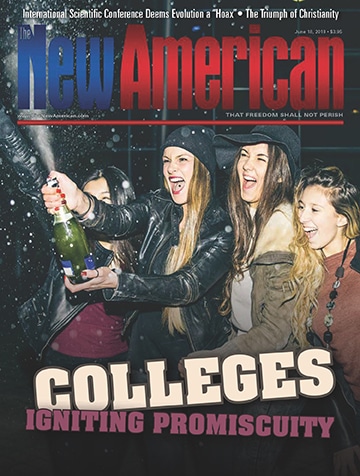Colleges Igniting Promiscuity
“Is it all about sex?!” The answer to this common leftist refrain, exclaimed when a traditionalist complains about some sexual-devolutionary agenda, is “Yes — you have made it so.” The “regressives” known as progressives have infused everything with sex, from media to entertainment to big business to, what is the topic here, education, with higher miseducation being the highest in lascivious content. Thus is it no wonder that Johnny not only can’t read but can’t tell right from wrong: Orgiastic environments don’t lend themselves to intellectual or moral development. Moreover, marry someone to vice on an emotional level, and he’ll be likely to later accept vice-imbued ideologies on an intellectual level.
British philosopher G.K. Chesterton predicted in 1926 that the “next great heresy is going to be simply an attack on morality; and especially on sexual morality…. The madness of tomorrow is not in Moscow but much more in Manhattan.” Philosopher C.S. Lewis, the foundation for whose conversion to Christianity (from atheism) was born of reading Chesterton’s books, once observed, “Sex is not messed up because it was put in the closet; it was put in the closet because it was messed up.” And just recently, at an early April conference at the Franciscan University of Steubenville, University of Virginia (UVA) religious studies Professor Vigen Guroian complained of higher education’s hypocrisy. Pointing out that colleges do in fact act in loco parentis, heavily policing alcohol and drug use, he asks why they also don’t police promiscuity. The short answer: When a heresy holds sway it becomes orthodoxy, at least for a time — and you don’t question orthodoxy.
Yet forget about policing promiscuity. Today’s colleges actually encourage it to a point of almost making Sodom and Gomorrah look saintly. Consider that the Ivy League’s Yale University hosted rapper Elizabeth Eden Harris, who goes by the moniker “cupcakKe,” at its April Spring Fling celebration. One student commentator called her emanations “sins, not songs” and “musical porn, plain and simple,” as she “sings about violent sex, oral sex, and having genitalia ‘like I’m eight,’” reports an April 11 College Fix headline. The details are even worse, but I’ll spare you.
Two days earlier, the College Fix reported that the “University of Tennessee at Knoxville is hosting ‘Sex Week’ [April 6 through 12] at which students will learn about a wide variety of sexual practices and topics,” including a class “titled ‘Butt Stuff 2.0: The Pegging,’” which we’ll not describe here. The Fix also informs, “Other events during the week include an art exhibit titled ‘Send Nudes ;),’ a cabaret show, and a workshop about ‘Black Liberation through Sexual Pleasure.’… Workshops such as ‘Masturbation Nation,’ ‘Trans Convo Starter Pack,’ ‘Tinder and Tea,’ and the ‘Science of Abortion’ are also on the schedule.”
Far from the above being an outlier, university Sex Week events are common today. For example, Campus Reform reported four years ago that the “University of Chicago is kicking off Sex Week 2014 with a ‘Lascivious Ball’ in which students will not be required to wear clothing.” In 2015, the College Fix informed that “Harvard University will soon mark its annual ‘Sex Week’ observance, which this year features a workshop on how to navigate sex involving bondage and sadomasochism in the dorms — complete with whips and floggers.” And in March, the publication told us that the “annual ‘Sex Week’ at Northwestern University will feature a Chicago-based dominatrix named ‘Lady Sophia’ who will teach the students various BDSM practices.”
Yet what transpires every other week in higher education can be just as sex-infused and confused. In 2011, Northwestern University psychology Professor J. Michael Bailey hosted a guest lecturer whose presentation was entitled “Networking for Kinky People” and which featured a live sex act on an auditorium stage. Also from the Fix (quotations are the publication’s):
• Dartmouth University offers physical education credit for undergoing “Sexpert” training.
• An area of study at the elite all-women’s Smith College “has the stated goal of ‘recognizing and disrupting notions of normative sexuality and gender.’”
• “A workshop offered at the University of Texas at Austin teaches students [that] bisexuality, pansexuality and ‘fluid sexuality’ should be embraced and supported.”
• “A discussion scheduled for later this month [April 2017] at California State University San Marcos appears slated to delve into the wild world of animal-based sex fetishes.”
One could fill volumes with such examples, but the point has been made.
Not surprisingly, this perversion extends beyond the classroom. Guroian penned a 2015 essay entitled “Sex and Danger at UVA” with William Wilson, professor emeritus of religious studies at the University of Virginia, in which the academics document that 18-year-old undergraduates really do enter “Dorm Brothels” (the title of a shocking 2005 article Guroian wrote). They presented the words a female UVA student wrote in a class assignment, relating, “Sex pervades almost every aspect of dorm life that I have experienced. I have seen ‘dorm incest’ (the entire floor hooks up with everyone else on the floor), [been] ‘sexiled,’ by my roommate having sex on my dorm bed, and witnessed date rape.”
Note that the term “hook up” (in the sense of sexual activity) was only attested “by 2003,” according to the Online Etymology Dictionary; this is no surprise. It’s a euphemism for “one-night stand” or “casual sex,” which itself is a euphemism for fornication. As sexual mores have degraded and the concept of “sin” has been shelved, the language has been correspondingly altered to put lipstick on the pig of promiscuity. So now sex, reduced to a mechanical act, can be described with a term for linking two pieces of machinery.
Another student provided even more detail, as Guroian and Wilson relate:
I arrived at UVA first semester just like many other female University students — wanting to make friends, excited for romance (genuine romance), and getting to know bright and intellectually motivated young men and women. Much to my surprise things were not so.... I had been thrown with others carelessly into a long-term hotel.
Most of the people in your dorm were in the “friend zone.” Everyone was a “guy.” But even with sweatpants on we recognized we had different body parts and late at night with a couple of beers things got more intimate. We were not so much male and female as we were xx who logically should give xy what they want and what we have. We were all one mutually using and abusing non-family.
Sexual license was actively encouraged and funded by the university. From “Spring-break fun packs” full of condoms and forms of contraception handed out at the student center with a cute note from a pudgy sunshine face wearing shades saying “Have a Fun Spring Break!” to “Sexual Arts and Crafts” flyers plastered on the dorm halls — the message is clear: college is a parent-funded motel party of casual and impersonal, but, yes, “safe sex.”
Related to this, an April College Fix article reported on Guroian’s recent Franciscan U. appearance and wrote that he “also lamented the end of single-sex colleges as a ‘great tragedy,’ claiming that many problems seen today would not exist if even just dormitories were single-sex. When he was a student in the 1970s, ‘no one thought unisex dorms was [sic] possible.’” Yet it has gone beyond this now: Some campuses — such as Wesleyan University, Hampshire College, Ithaca College, and even Massachusetts Institute of Technology, to name just a handful — have clothing-optional halls, dorms, and, sometimes, whole campuses (virtually all students still regularly wear clothing, but reports of seeing an undergraduate au naturale are not uncommon).
Photo: oneinchpunch/ iStock / Getty Images Plus
This article appears in the June 18, 2018, issue of The New American.


